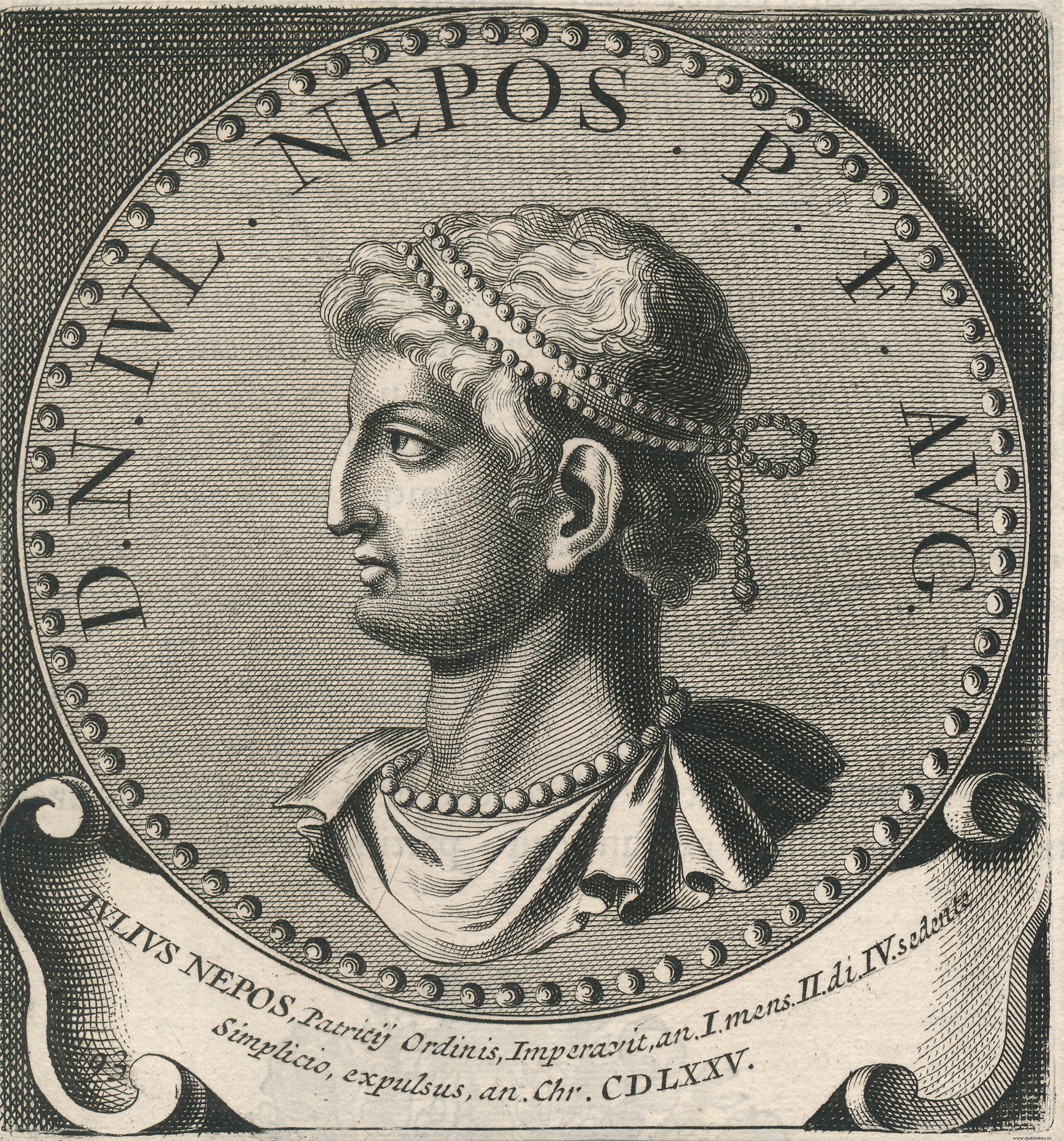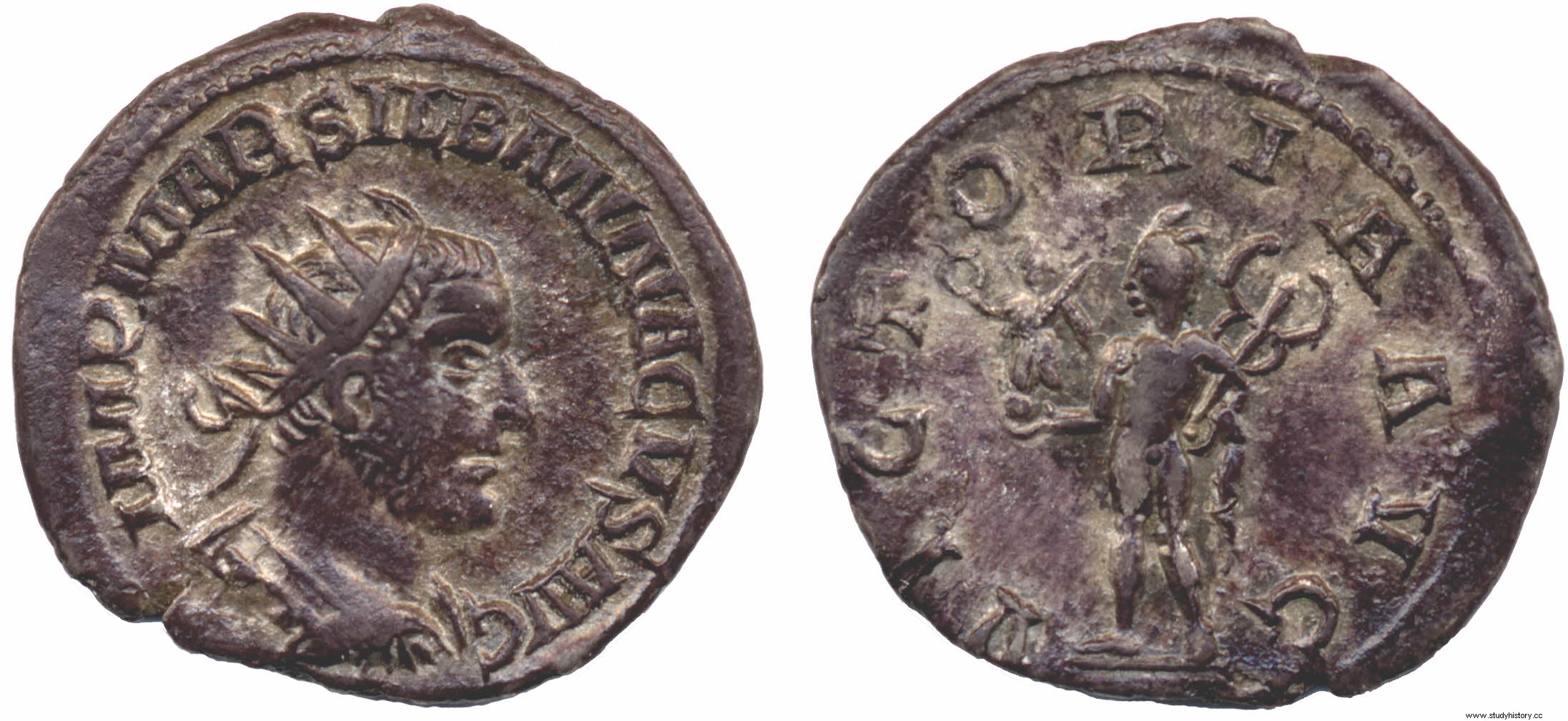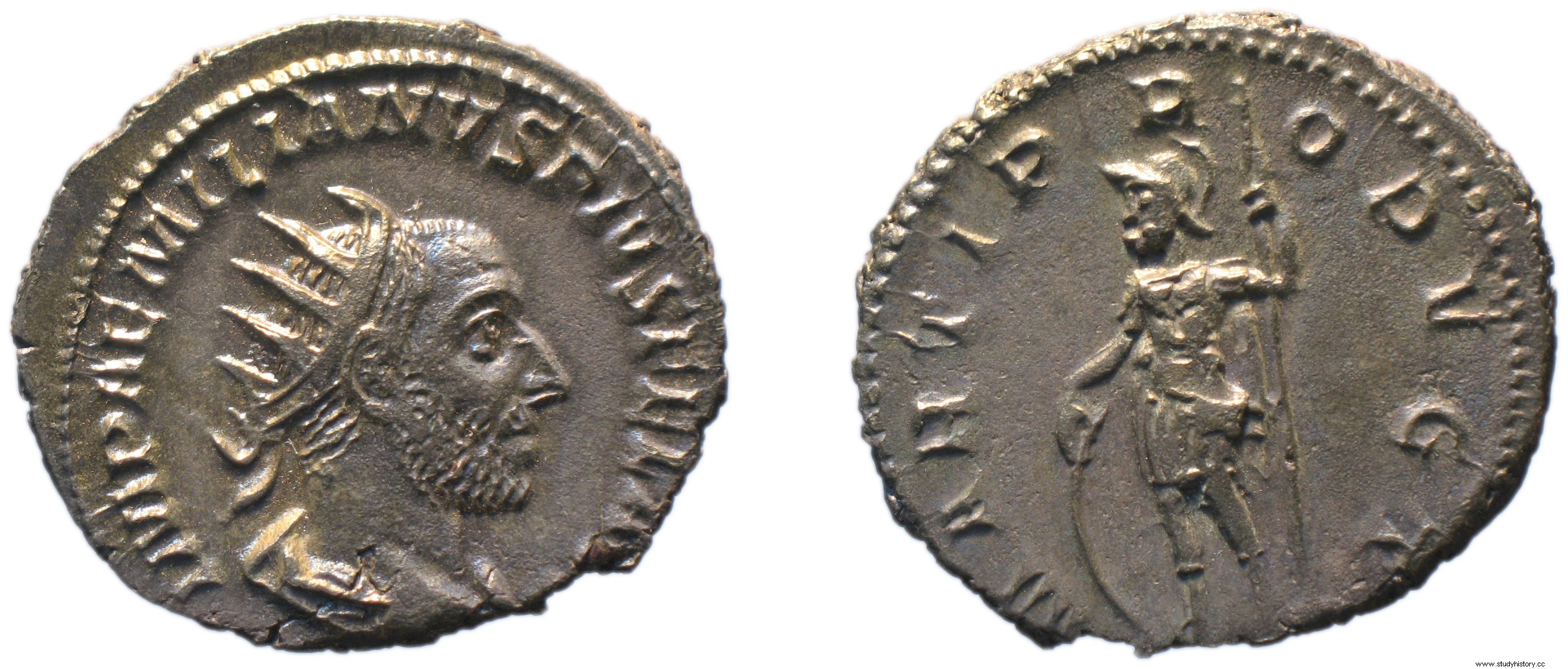The list of known Roman emperors contains many names, from the principate that Augustus in 27 B.C. started (and continued with the Julio-Claudian dynasty) to the domination where the Empire was ruled by several emperors (augusti and Caesares ) was ruled. Throughout this list there are also occasional names of emperors who claimed this title and (usually only for a short time) ruled as usurper over part of the Roman Empire, e.g. Galba , Otho and Vitellius during the infamous Year of the Four Emperors 69 AD. A name that is much less known, due to not being reported in literary sources, is that of Silbannacus . Who was this unknown Roman who may have claimed the emperorship during the middle of the 3 de century, a rather obscure period in Roman history?
Usurpers

A 19th century illustration of the transfer of the imperial crown by Romulus Augustus to the Germanic ruler Odoacer
The last emperor - at least of the Western Roman Empire - Romulus Augustulus , after a very short reign in AD 476. deposed by the Germanic captain Odoaker , who later also crowned himself king and ostensibly passed on the emperorship to the then Eastern Roman emperor Zeno . This traditionally ends a period spanning four centuries in which countless dynasties claimed power in Rome, interspersed with periods of chaos and anarchy in which, sometimes for a very short period of time, a local or military leader claimed power. Such a usurper was often short-lived, as the success of the revolts often depended on the (military) backup of the ruler in question and the ruling or succeeding emperor usually showed no compassion for such a defeated rebel.
In addition to the trio of the Year of the Four Emperors already mentioned, for example, the infamous Elagabalus perished. as. He ruled for four years, but was eventually also killed by the Praetorian Guard. It was even less successful Nymphidius Sabinus , the prefect of the same guard, who after Nero's death thought he could claim the imperial throne as the unrecognized son of Caligula . He was sadly robbed of his life by his own guard when Galba was to enter Rome.

Engraving in a medallion of Julius Nepos, the last legitimate emperor of the Western Roman Empire
Other lesser-known figures who found themselves in the folds of Roman imperial history were, for example, Avidius Cassius , the governor of Syria, who in 175 AD. even after the rumor he heard about the death of Emperor Marcus Aurelius proved to be untrue, yet continued his unsuccessful revolt. Some others were never accepted by the Senate as legitimate emperors or succeeded only in taking control of part of the empire, often for a short time. Finally, Julius Nepos . tried to reclaim the title of emperor as ruler in exile in Dalmatia after the aforementioned Odoacer seized power in Rome, but that attempt also failed when he was killed by his own soldiers in 480.
Well-known successful and legitimate usurpers included Septimius Severus and Constantine the Great who were both proclaimed emperors by their own army. A constant factor in their seizure of power (besides military support) was the legitimization of their emperorship. This happened in various ways, for example by setting up construction activities or having their own coins minted, whereby their emperorship referred to the Roman gods, their predecessors as emperors or their deified status (after their death) through all kinds of symbols. Both ruled the empire for 18 and 31 years respectively and were succeeded by their own dynasty.
The Mysterious Coins

The silver coin of Silbannacus from the British Museum
All these aforementioned emperors are known to us not only from literary sources, but also from inscriptions, coins and other archaeological remains. However, when in 1937 the British Museum came into possession of a silver coin (an antoninianus ), bought from a Swiss trader who claimed the coin was found in the French region of Lorraine, investigators weren't sure what they were seeing. The obverse of the coin reads:
IMP MAR SILBANNACVS AVG
This emperor Mar() Silbannacus puzzled the specialists. No emperor with this name is known to us from the sources and it was thought that this may be a misspelling of the name Silvannacus or Silvaniacus could go, but even in that case no emperor by that name was known. The reverse, depicting the gods Mercury en Victoria (with a caduceus or olive crown and the accompanying text “VICTORIA AUG”), gave no further hints as to the origin of this coin. It was suggested that it could be the coinage of a usurper, between the obscure years 238 and 260 AD, but there was no certainty about the historicity of Silbannacus.
This lasted until in 1996 a second coin with the same emperor's name appeared at a French specialist. This silver coin would also come from France and was found a few years earlier near Paris. The obverse of this coin was identical to the first, but this time the reverse featured the god Mars (and the text “MARTI PROPVGT”). This led the researchers to Emperor Aemilianus which in 253 A.C. reigned for three months and had used the same reverse side with the god of war ("the Defender") for a coin. Was it finally clear that the Silbannacus featured on these mysterious coins was a usurper during that chaotic year when several revolts and emperors reigned?

Silver Antoninianus of Aemilianus, with Marti Propugt (Propugnatori), Mars the Defender on the back
Silbannacus, the unknown emperor?
The name Mar() Silbannacus creates even more mystery. Even if it were a misspelling, there seems to be a possible connection to the god Silvanus , a Roman deity of the forests who may have descended from an Etruscan deity. The suffix -acus, which indicates a Celtic etymology, also reinforces the suspicion that we should look for the background of Silbannacus in northern Italy (where Celts and Etruscan influences overlapped). The other abbreviation MAR() can be an abbreviation of the name 'Marinus ’, ‘Marius ’ or ‘Marcius ’, as it was less common to use a praenomen – ‘Marcus ' in that case - to be used on the coinage. Here too we are left with suspicions, since none of these families from the 3 de century are known to us from other sources.
The antoniniani or silver-plated coins (devalued to bronze during the 'Crisis of the third century') were common in this period and the images on the obverse and reverse also give little hint as to their dating. In the middle of this century we find an image of the emperor with a similar crown on almost all coins, but this did not lead to a more exact dating.

Bust of Emperor Philip I Arabs

Bust of Emperor Decius
Ultimately, a usurper's theory remains the most prevalent, at least until we possibly find more source material one day. Two possibilities were most often suggested. First, that Silbannacus was operating as a military leader in Germania Superior near the Rhine area. Eutropius (IX.4 ) describes a civil war in Gaul, possibly during the reign of Emperor Philip I Arabs (244-249 AD) or more likely during that of Emperor Decius (249-251 AD), in which case Silbannacus may have briefly claimed the emperorship.
The discovery of the second coin and also the alternative reading of Eutropius' civil war in Galatia make the second theory more plausible:the Silbannacus coin would then have been minted in Rome after a brief period of revolt between the battle for the throne in AD 253. It had already begun when in A.D. 251. Emperor Trebonianus Gallus Aemilianus as commander of the army troops to the Danube to fight the Goths there (Zosimus , I.28.3 ). Aemilianus won an important battle there in the summer of 253 AD. and his soldiers then proclaimed him emperor. Subsequently, Trebonianus sent another army chief Valerianus – later known as Emperor Valerian I – set out to stop Aemilianus from his province, but this happened too late, so that Aemilianus had already taken power in Rome. Valerianus had meanwhile also allowed himself to be proclaimed emperor on the Rhine, which forced Aemilianus to march against Valerian with his soldiers. Like previous examples, Aemilianus was murdered by his own soldiers and Valerian was able to go to Rome as the new emperor. During these events, our Silbannacus would have taken control of the empire's capital, only to be eventually deposed and probably killed by Valerian's troops. Hypothetically, Silbannacus could even have been a commander under the command of Aemilianus, who then claimed power in Rome during his absence or after his death.
Conclusion
It is difficult to confirm which hypothesis is correct without additional source material. There is little doubt that if Silbannacus allowed himself to be proclaimed emperor - and that is what the two coins indicate - this would probably have been only a short-term usurper during the turbulent crisis period in the middle of 3 de century. That he would then more than likely have met his end in a not too peaceful manner, either at the hands of the troops of Philip I Arabs, Decius, Valerian I or perhaps even his own soldiers, also seems a plausible scenario. The rest, like his coins, remains a mystery for now…
